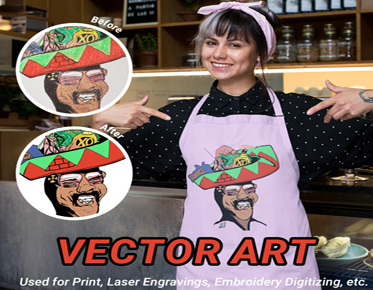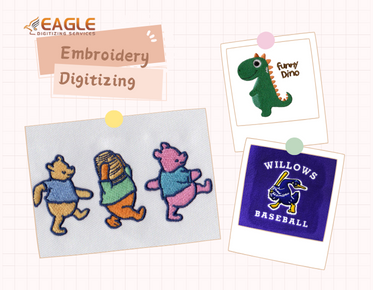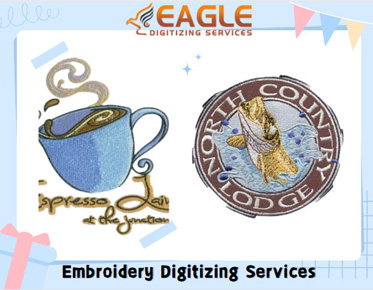Mastering the Art of Precision: Exploring Hyper-Realistic Vector Designs
Art has always been about pushing boundaries, but when precision meets creativity, the result is a jaw-dropping marriage of technical skill and aesthetic brilliance. Hyper-realistic vector art exemplifies this synergy. It's where meticulous detail converges with digital innovation, resulting in artworks so lifelike they could be mistaken for photographs.
What
Is Hyper-Realistic Vector Art and Why Does It Matter?
Hyper-realistic
vector art is a form of digital artistry where precision reigns supreme. Artists
use scalable vector graphics (SVGs) to create images that mimic the depth,
texture, and realism of real-life subjects. Unlike traditional art forms, these
pieces maintain clarity and quality no matter the scale, making them vital in
industries like advertising, product design, and beyond. The versatility of
vector graphics allows artists to create artwork that can be reproduced on
everything from billboards to business cards without any loss of detail. This
makes hyper-realistic vector art invaluable in the digital age, where visual
content must be adaptable and high-quality across multiple platforms and
mediums.
How
Precision Turns Creativity Into Masterpieces
Precision
doesn’t stifle creativity—it enhances it. When every anchor point, curve, and
gradient is meticulously placed, the artistry shines. Precision acts as the
scaffolding, allowing creativity to flourish within boundaries, much like a
symphony guided by a maestro. With a strong foundation in technical skills, the
artist can push the limits of creativity, experimenting with texture, lighting,
and form, knowing that their vision will be executed flawlessly. Precision in
vector art doesn't limit spontaneity; rather, it provides the control needed to
explore complex designs and deliver the finest details, turning raw ideas into
visual masterpieces.
The
Basics of Vector Art
Breaking Down Vectors: The
Building Blocks of Digital Art
At
its core, vector art uses mathematical equations to create images. Forget
pixels; this is all about paths, nodes, and curves. Each line and shape is
calculated, ensuring the art remains crisp regardless of size. It's art
governed by math, yet brimming with soul. Vectors rely on geometric formulas to
form smooth, scalable lines and shapes, enabling artists to manipulate designs
with immense flexibility. Unlike pixel-based raster art, vector images can be
resized infinitely without losing sharpness or quality, making them ideal for
modern digital environments where adaptability is key.
Understanding the Tools:
Software and Resources for Vector Design
The
modern vector artist's arsenal includes tools like Adobe Illustrator, CorelDRAW,
and Affinity Designer. These software options offer everything from simple
shape creation to complex layering and texturing. Free alternatives like Inkscape
ensure anyone can start without breaking the bank. Each tool offers unique
features that cater to different artistic needs, from the beginner exploring
digital art to the seasoned professional creating high-end designs. These
platforms provide the flexibility and power to manipulate every element of an
artwork, ensuring that every line, curve, and color choice is finely tuned to
perfection.
What Makes Hyper-Realism in Vector Art Unique
Hyper-Realism vs. Traditional
Vector Art: Key Differences
While
traditional vector art leans towards simplicity and clean lines, hyper-realism
pushes boundaries with intricate textures, depth, and photorealistic lighting.
The goal is to create an experience rather than only an image. Hyper-realistic
vector art takes the precision of traditional vectorgraphics and amplifies it with highly detailed features like shadows,
gradients, and reflections, making the image appear lifelike.
This requires a deeper understanding of light, color theory, and
texture to achieve effects that mimic the real world, transforming a simple
vector design into a visual masterpiece.
The Power of Detail: Why
Hyper-Realistic Art Captures Attention
People
are naturally drawn to detail. Hyper-realistic vector art captivates because it
mirrors life itself, offering a mesmerizing interplay of precision and illusion
that keeps viewers hooked. The level of detail can be both a visual treat and a
mental puzzle, making it impossible to look away. Every tiny nuance—whether
it’s the subtle texture of a skin surface, the intricate weave of the fabric,
or the glint of light on metal—pulls the viewer in, making the artwork feel almost
tangible. It's this attention to detail that sets hyper-realistic vector art
apart and gives it the power to create lasting impressions.
Tools of the Trade
Must-Have Software for Creating
Stunning Vector Designs
Adobe
Illustrator is the reigning king for professionals, but alternatives like
Affinity Designer bring competitive features at a fraction of the price. Sketch
is a favorite among UI designers, while Procreate offers a hybrid approach for
drawing-based vector workflows. Each of these tools enables the creation of
complex and nuanced designs, but they also cater to different workflows and
artistic preferences. For example, Adobe Illustrator offers an extensive range
of advanced features for experienced artists, while Procreate’s intuitive interface
allows artists to quickly sketch out ideas before fine-tuning them in
vector-based software. Finding the right tool depends on your specific needs
and artistic vision.
Exploring Hardware: Tablets,
Styluses, and Monitors
A
quality drawing tablet like a Wacom or an iPad with an Apple Pencil can
transform your workflow. Pair these with a high-resolution monitor to ensure
every detail pops. The right hardware bridges the gap between vision and
execution. Tablets offer a more natural drawing experience with pressure
sensitivity, allowing for more dynamic, responsive designs, while a
high-resolution monitor helps artists maintain pixel-perfect accuracy. The
precision that comes with these devices elevates the vector art process,
ensuring that every curve and line is rendered exactly as intended.
Foundations of Precision
The Role of Geometry and
Mathematical Accuracy
Geometry
is the unsung hero of vector art. Whether crafting a symmetrical logo or
mapping the contours of a hyper-realistic face, mathematical precision ensures
harmony and balance. The interplay of curves, angles, and shapes forms the very
structure of vector art, helping artists create designs that are visually
striking and structurally sound. Precision in geometry allows for flawless
design adjustments, whether scaling a piece up or down, ensuring that visual
integrity is maintained throughout the process.
Mastering Anchor Points and
Bezier Curves
Anchor
points and Bezier curves are the bread and butter of vector design. They allow
artists to define and refine shapes with pinpoint accuracy. Mastering them is
like learning to wield a scalpel—it’s about finesse and control. Bezier curves,
in particular, offer artists the ability to create smooth, flowing lines that
are critical for achieving hyper-realism. By learning how to manipulate these
curves and anchor points, an artist gains the ability to shape every curve and
contour with unmatched precision, unlocking a world of creative possibilities.
The
Journey to Hyper-Realism
From Sketch to Digital: Planning
Your Masterpiece
Every great piece starts with a plan. Begin with a rough sketch,
outline your vision, and identify the textures, light sources, and details that
will bring the design to life. The planning phase is essential to create a
roadmap for your artwork. It allows the artist to make decisions about
composition, balance, and the integration of complex elements before jumping
into the technicalities of vector creation. A
clear plan ensures that the final product has a cohesive flow, transforming
what could be a disjointed mess into a stunning visual experience.
The Importance of Layering and
Organization in Complex Designs
Layers aren’t just helpful—they’re essential. Organize elements
logically to avoid chaos. A well-layered file is a gift to your future self and
collaborators. Layers allow for non-destructive editing, making it easier to
adjust or refine individual elements without disturbing the rest of the
artwork. For hyper-realistic vector art, where detail is key, layering is
especially important to manage complex designs, ensuring that intricate
textures, shadows, and highlights are applied with precision without
interfering with the base structure of the image.
Techniques
for Hyper-Realistic Effects
Achieving Depth with Gradients
and Blending Modes
Gradients
mimic light transitions while blending modes add complexity. Combine these to
create surfaces that feel tangible and multi-dimensional. Gradients smooth the
transition between colors, while blending modes allow different layers to
interact, creating a more dynamic, realistic result. With the right
application, these techniques can transform flat designs into visually rich
compositions that seem to pop off the screen. Experimenting with various
gradient types and blending modes can result in lifelike textures and lighting
effects that breathe life into any vector piece.
Perfecting Textures: Adding Life
to Flat Surfaces
Textures breathe life into designs. Use subtle grain effects or
intricate patterns to add realism. Experimenting here can transform a flat
design into a tactile wonder. Textures give the illusion of depth and
materiality, whether it's the softness of skin, the roughness of concrete, or
the smooth shine of glass. By layering textures over basic shapes, an artist
can create the illusion of a real-world object in a way that pure vector shapes
simply can't achieve on their own.
Playing with Light and Shadow
for Realism
Light and shadow are the soul of realism. Study how they interact in
the real world and replicate that interplay in your art. The result? The visual
depth feels almost touchable. Understanding how light affects the surface of
different materials is crucial for creating a hyper-realistic effect. By
applying gradients, overlays, and strategically placing shadows, artists can
simulate the way light bounces off surfaces, adding volume and dimension to
their work. This mastery of light and shadow is what separates basic vector art
from hyper-realistic designs that evoke a sense of depth and
three-dimensionality.
Inspiration and Style Development
Where to Find Inspiration for
Hyper-Realistic Vector Art
Look
everywhere—nature, architecture, photography. Platforms like Behance and
Dribble are treasure troves for ideas. Inspiration is abundant if you keep your
eyes open. Real-life observations, especially of natural textures and light
interactions, can spark fresh ideas. When you're stuck, these online platforms
offer a sense of community, where you can explore works from artists worldwide.
Whether it’s a simple object, a complex urban scene, or even a specific color
palette, inspiration can strike from the most unexpected places, fueling the
next great hyper-realistic project.
Developing Your Signature Style:
Standing Out in the Crowd
Experimentation is key. Combine influences from various sources to craft a style that’s unmistakably yours. Consistency and uniqueness will make your work memorable. Developing a signature style goes beyond mastering technical skills; it’s about expressing your artistic voice through the medium. By exploring different techniques and combining them in new ways, you can discover a look that feels authentically yours. Over time, refining your style makes your work instantly recognizable, helping you stand out in the competitive world of digital art.



